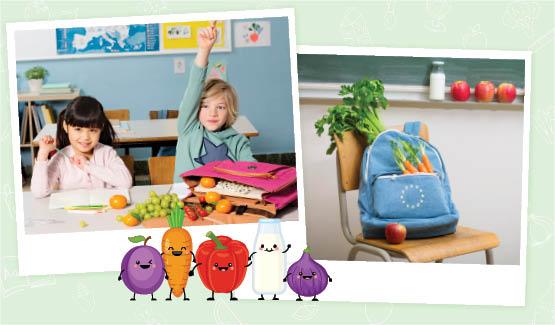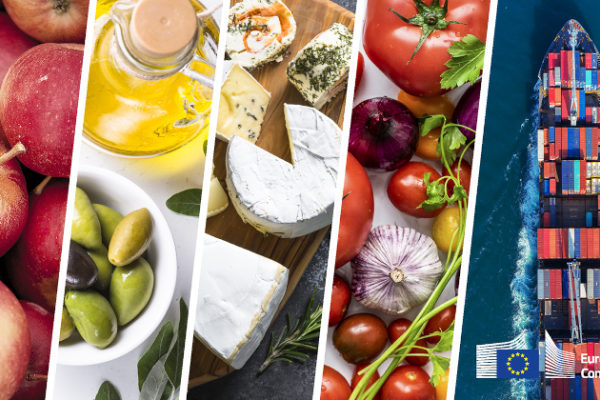
The EU school scheme supports the distribution of milk, fruit & vegetables to millions of children, from nursery to secondary school, across the EU. It is applicable since 2017 and the Commission has now launched a review of this scheme as part of the Farm to Fork strategy.
Aims
Consumption of fresh fruit, vegetables and milk in the European Union does not meet international or national nutritional recommendations. On the other hand, consumption of processed food, which is often high in added sugar, salt, fat or additives, is on the rise.
Unhealthy diets, together with low physical activity, result in obesity. This is why the EU takes action to encourage children to follow a healthy diet and lifestyle.
Overview
Applicable since 1 August 2017, the EU school fruit, vegetables and milk scheme combines two previous schemes (the school fruit and vegetables scheme and the school milk scheme) under a single legal framework. This allows for greater efficiency and an enhanced focus on health and education. The scheme supports the distribution of products, educational measures and information measures.
Distribution
The scheme supports the distribution of fruit, vegetables, milk and certain milk products to schoolchildren, from nursery to secondary school. EU countries approve a list of products (in collaboration with their health and nutrition authorities) which will help achieve the schemes objective of helping children to follow a healthy diet.
The priority is for fresh fruit and vegetables and for plain milk. In order to support a varied diet and/or specific nutritional needs, EU countries may also make processed fruit and vegetables such as juices and certain milk products such as yoghurt and cheese, available. Additionally, under stricter conditions, milk-based drinks may be included.
Seasonality, variety, availability, health and environmental aspects underpin the choice of products. EU countries may encourage local, short-supply chain, organic and quality scheme products if they wish. Generally, no added sugar, salt, fat and sweeteners or artificial flavours are allowed. The health and nutrition authorities in EU countries may allow, as an exception, limited quantities of added salt, fat and, for milk products, sugar.
Educational measures
The scheme also supports educational measures. This can include lessons but can also help fund farm visits, school gardens, tasting and cooking workshops, theme days and games.
Their objective is to reconnect children to agriculture and teach them about healthy eating habits. Issues such as local food chains, organic farming, sustainable production or food waste may also be covered. Educational activities may also involve teachers and parents as they are role models for children’s healthy eating habits and lifestyles.
Information measures
Funding is also available for information activities to ensure the visibility of the scheme, as well as monitoring and evaluation to account for the proper functioning of the scheme.
Review of the scheme
A public consultation of the EU school fruit, vegetables and milk scheme took place from 5 May until 28 July 2022. This consultation was conducted as part of the Farm to Fork strategy that aims to increase the scheme’s impact on sustainable food consumption and strengthen educational messages on healthy nutrition.
The executive summary of the evaluation support study of the EU school scheme is published in order to support the review of its legislative framework.
The Commission presented findings from the evaluation support study, public consultation and Eurobarometer 520 during the ‘An EU school scheme fit for the future’ conference, which took place in Brussels on 24 November 2022. Public and private stakeholders were able to share their views and suggestions on initial proposals.
Budget
After the withdrawal of the United Kingdom from the EU, the total EU budget for the scheme amounts to €220.8 million per school year, consisting of up to €130.6 million for fruit and vegetables and up to €90.1 million for milk.
Indicative EU budget by country for the period from 1 August 2023 to 31 July 2029
Each country may transfer part of its EU budget for fruit and vegetables to milk, or vice versa, depending on its priorities and needs. It may also request only part of its budget, or conversely more than its budget. The European Commission adopts a decision to fix the EU budget by country for each school year.
From school year 2023/2024 onwards, aid applicants have the possibility to request advances (up to a maximum of 80% of the aid applicants are entitled to).
2022/23 school year – EU budget by country
2021/22 school year – EU budget by country
2020/21 school year – EU budget by country
2019/20 school year – EU budget by country
Redistribution of 2022/23 funding to support displaced Ukrainian children
In June 2022, the Commission published a regulation which invited EU countries to review their requests for aid under the school scheme for the 2022/23 school year. This came in light of the unprecedented situation brought about by Russia’s invasion of Ukraine, which calls for solidarity between EU countries to ease the burden on those at the forefront of catering for displaced Ukrainian children.
EU countries submitted either the additional amount they were requesting under the scheme, or the amount of their national allocation that was not required. Any unused amounts were redirected to the countries welcoming the highest number of Ukrainian children. As a result, a total of 2.9 million euro was redistributed to cater for the needs of displaced Ukrainian children in EU schools.
School scheme by country
Countries that wish to participate in the scheme draw up a strategy, at national or regional level, covering a period of six years.
Each country's strategy outlines the objectives (such as an increase in fruit and vegetables consumption to meet the recommended five portions per day), the beneficiaries (e.g. children in primary schools), the products, the education activities and arrangements for the implementation of the scheme.
Each participating country is required to monitor and evaluate the scheme. Monitoring reports cover each school year.
Evaluation reports from the period 2017-2022 were submitted to the Commission and are respectively available in each EU country's webpage.
The Commission does not approve the countries’ strategies, or monitoring and evaluation reports. It makes them public, together with providing a contact point in each country for information on how to participate and details on implementation.
Strategies, evaluation, monitoring reports and contacts by country.
Legal bases
The following regulations set out the EU school fruit, vegetables and milk scheme (please refer to the consolidated version of each regulation):
- Regulation (EU) No 1308/2013, Articles 22 to 25 and Annex V;
- Council Regulation (EU) No 1370/2013, Article 5 and Annex I;
- Commission Implementing Regulation (EU) 2017/39, with rules for uniform implementation of the scheme;
- Commission Delegated Regulation (EU) 2017/40, with additional specific rules for the implementation of the scheme.
Documents
- Downloadбългарски(1.36 MB - PDF)
- Downloadespañol(1.36 MB - PDF)
- Downloadčeština(1.38 MB - PDF)
- Downloaddansk(1.36 MB - PDF)
- DownloadDeutsch(1.39 MB - PDF)
- Downloadeesti(1.36 MB - PDF)
- Downloadελληνικά(1.36 MB - PDF)
- Downloadfrançais(1.36 MB - PDF)
- Downloadhrvatski(1.37 MB - PDF)
- Downloaditaliano(1.37 MB - PDF)
- Downloadlatviešu(1.37 MB - PDF)
- Downloadlietuvių(1.38 MB - PDF)
- Downloadmagyar(1.38 MB - PDF)
- DownloadMalti(1.38 MB - PDF)
- DownloadNederlands(1.37 MB - PDF)
- Downloadpolski(1.38 MB - PDF)
- Downloadportuguês(1.37 MB - PDF)
- Downloadromână(1.38 MB - PDF)
- Downloadslovenčina(1.38 MB - PDF)
- Downloadslovenščina(1.39 MB - PDF)
- Downloadsuomi(1.37 MB - PDF)
- Downloadsvenska(1.37 MB - PDF)
- Downloadбългарски(556.8 KB - PDF)
- Downloadespañol(575.19 KB - PDF)
- Downloadčeština(582.75 KB - PDF)
- Downloaddansk(579.42 KB - PDF)
- DownloadDeutsch(591.81 KB - PDF)
- Downloadeesti(572.78 KB - PDF)
- Downloadελληνικά(567.64 KB - PDF)
- Downloadfrançais(584.45 KB - PDF)
- Downloadhrvatski(580.29 KB - PDF)
- Downloaditaliano(577 KB - PDF)
- Downloadlatviešu(579.51 KB - PDF)
- Downloadlietuvių(573.47 KB - PDF)
- Downloadmagyar(595.81 KB - PDF)
- DownloadMalti(590.25 KB - PDF)
- DownloadNederlands(575.11 KB - PDF)
- Downloadpolski(583.72 KB - PDF)
- Downloadportuguês(579.12 KB - PDF)
- Downloadromână(586.09 KB - PDF)
- Downloadslovenčina(589.45 KB - PDF)
- Downloadslovenščina(595.99 KB - PDF)
- Downloadsuomi(570.34 KB - PDF)
- Downloadsvenska(587.28 KB - PDF)


